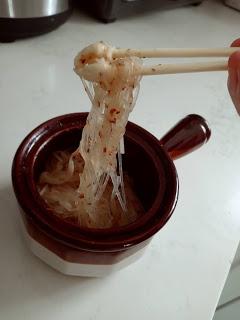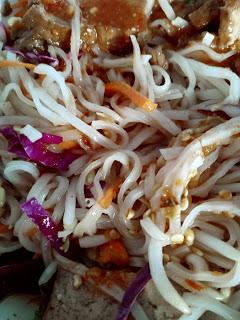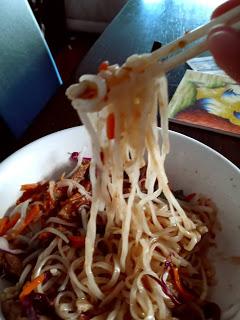In my class at GCE lab school, we have learned about where food comes from. We watched documentaries, and we read articles about the food we eat and where it comes from as well as how much people worked to make it. The labels on food and the catchphrases on packages are more important than we think. We also talked about Michael Pollan, and Norman Borlaug. We even went on a field experience to a green farmers market to talk to people about their food that they are selling. I will be writing a store bought food vs restaurant food review for this project. The food I will be comparing is vegetarian rice noodle dishes. I will first be making the homemade meal by myself with the ingredients and noodle pack I have at home. I will then be eating my restaurant meal for dinner at Penny's noodle shop, a cute Thai and Asian restaurant that I often go to. My favorite restaurant to go to is Penny’s noodle shop, but I also know I like store bought noodles packs, so I wonder what the differences that I will note will be.
Store bought pack review
I will be making spicy vegetarian noodles. These noodles were made very quickly and easily, but do they taste good? When I look at them, they look very sloppy and stringy. Smelling them before I tried them, they smelled like spice, pungent. Texture: Squishy, chewy, sticky. Sound: Squishy, sticky. Taste: Pungent, salty. The dish appears industrial. Ingredients: Thin noodles, crushed red pepper, Italian seasoning, rice, tapioca starch, water, onion, Thai lime, garlic, spring onion, salt, sugar, corn maltodextrin, yeast extract, citric acid, shrimp powder(vegan), tamarind powder, soybean oil, shallot.



Restaurant dish review
Vegetarian bowl. This dish looks crunchy, hot, and delicious. The dish smells pungent in a good way, and hot. It feels like liquid, vegetables, and noodles. The texture is chewy. There isn’t much sound, but when I eat it it sounds crunchy and slurpy. This dish tastes pungent, a bit salty, a bit sweet, and astringent. The dish appears organic and fresh because there are lots of vegetables in it.




Comparison:
I prefer the one at penny’s. It tastes a lot more fresh, it is less sticky, and there is more taste and textures in it with lots of vegetables. The biggest difference between the two dishes was the texture. The first one was sticky with no liquid or vegetables. The one at Penny’s was the opposite in that sense. I recommend the vegetarian bowl at penny’s noodle shop. It has a good mix of flavors and it leaves a warm healthy feel after and when you eat it. It has not too thin rice noodles, and they aren’t overwhelmingly chewy or sticky. I like this dish a lot! I did observe evidence of a transformation between these meals. The “quality to quantitative” transformation. I noticed that the store bought noodles were cheap and easy to make. There were ingredients that I saw that I didn’t recognize. The dish at Penny’s noodle shop seemed to be much healthier, tastier, and more expensive. This is what I noticed.
Something I would like to show that is something I learned in this class is a way to decode food labels! Here it is:
Part 1: I found three foods that I eat regularly, or that I often eat/use, and I wrote down unfamiliar ingredients I saw on the back of their package.
Food #1:Hummus, (significantly spicy, park street deli) Unfamiliar ingredients: sesame tahini, and guar gum.
Food #2:Hot sauce (sriracha, huy fong foods INC.) Unfamiliar ingredients:Acetic acid, potassium sorbate, and sodium bisulfite.
Food #3:soy pattie, (impossible burger patties) Unfamiliar ingredients:Methylcellulose, cultured dextrose, soy leghemoglobin, and mixed tocopherols.
|
Part 2: I found three healthy foods and wrote down their food labels for marketing and stuff like that.
Food #1: soy pattie, (impossible burger patties) Marketing Labels/Catchphrases: “IMPOSSIBLE” “BURGER PATTIES MADE FROM PLANTS” “JOIN THE MOVEMENT” “SAVE THE PLANET”.
Food #2: blueberries, (driscoll's) Marketing Labels/Catchphrases: “only the finest berries”
Food #3: cheese, (emporium selection) Marketing Labels/Catchphrases: “aged manchego sheep’s milk cheese with a buttery texture and distinct flavor”
|
Part 3: I choose five ingredients from the unfamiliar ingredients that I noticed and I looked up information about the ingredients. I looked up the purpose of the ingredient, the safety of the ingredients, and I read other facts about the ingredient. For each ingredient, I looked it up on the Center for Science and Public Interest website.
Ingredient #1:
guar gum What is the purpose of the ingredient (coloring, antioxidant, emulsifier, nutrient, etc)
Center for Science and Public Interest says that gums are thickening agents, and stabilizers. It has given allergic reactions, but Center for Science and Public Interest don’t know if it is because of the gum or something else. (certain people should avoid) Gums are used to replace fat in ice cream, baked goods, and salad dressings.
Ingredient #2:
Acetic acid What is the purpose of the ingredient (coloring, antioxidant, emulsifier, nutrient, etc)
Acetic acid is a preservative, flavorer, and acidulant. The safety of the ingredient (Safe, Cut Back, Caution, Avoid) According to Center for Science and Public Interest, Acetic acid is safe. Acetic acid is what gives vinegar its sharp taste and odor.
Ingredient #3:
Methylcellulose What is the purpose of the ingredient (coloring, antioxidant, emulsifier, nutrient, etc) According to Center for Science and Public Interest, cellulose prevents caking and clumping, it binds water, and it improves texture, thickens, emulsifies, and is used as a filler. The safety of the ingredient (Safe, Cut Back, Caution, Avoid)
According to Center for Science and Public Interest, Cellulose is safe. According to Center for Science and Public Interest, the cellulose added to processed foods usually comes from wood pulp (saw dust) or cotton lint.
Ingredient #4:
cultured dextrose What is the purpose of the ingredient (coloring, antioxidant, emulsifier, nutrient, etc)
According to Center for Science and Public Interest, dextrose is a sweetener. According to Center for Science and Public Interest, dextrose is cut back. Dextrose turns brown when heated.
Ingredient #5:
Potassium sorbate What is the purpose of the ingredient (coloring, antioxidant, emulsifier, nutrient, etc)
Potassium sorbate prevents the growth of mold Potassium sorbate is safe. Potassium sorbate occurs naturally on many plants.
|
Part 4: Then I chose 3 of the label/catchphrases I wrote down earlier, and wrote down if they were reliable or not and why.
“IMPOSSIBLE” “BURGER PATTIES MADE FROM PLANTS” “JOIN THE MOVEMENT” “SAVE THE PLANET”. Yes it is reliable, because it says the ingredients on the back, which have plants in them. I can't find who regulates the companies.
“only the finest berries” This one is not reliable, it is just a catchphrase because they want to promote their berries. I can't find who regulates the companies.
“aged manchego sheep’s milk cheese with a buttery texture and distinct flavor” This one is reliable, because before it is sold there is taste testing, and the results to describe it is what they put on the labels. I can't find who regulates the companies.
|
Comments
Post a Comment